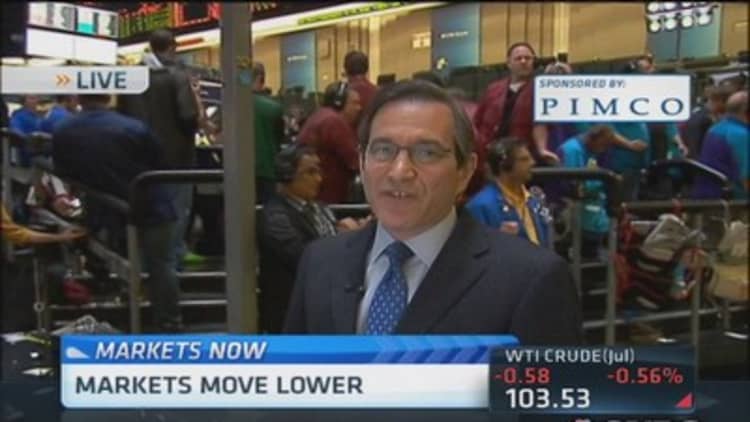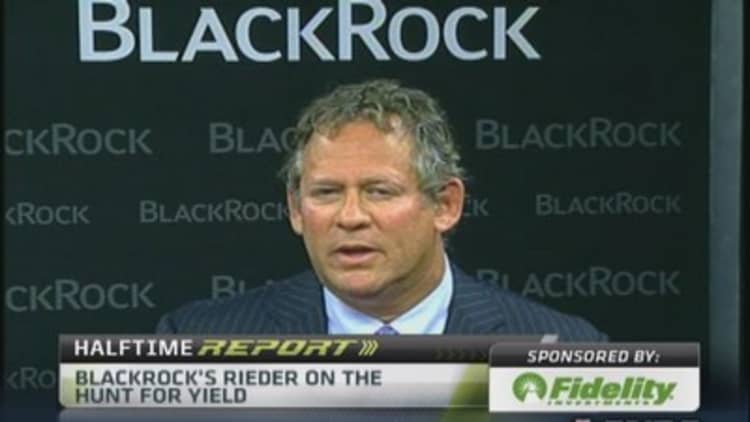Traders blame the surge in Treasury buying this week on everything from short covering and China buying to a flight to safety amid global economic jitters.
But Rick Rieder, BlackRock's co-head Americas fixed income, said it's likely a confluence of factors, noting the trend may have turned on the front end. He expects the 10-year yield to rise to 3.0-3.25 percent by year-end.
The move comes as global rates fall and the U.S. market looks attractive relative to German Bunds and Japanese government bonds, he said.
Read MoreDennis Gartman says to buy bonds on any dips
Easy policy from major central banks is fanning buying. The Federal Reserve has promised low rates for longer, even as it slows bond purchases, and so far inflation is not an issue. But the European Central Bank has been a bigger catalyst recently. It's expected to cut rates next week and possibly discuss an asset purchase plan. This sent rates lower in Germany and around the periphery.
"I certainly think we've bottomed in the front end and the back end stays in this range with the proclivity of moving moderately higher. I think we're going to stay in a low range for quite a long time," Rieder said of Treasury yields.
Yields fell Thursday morning but by afternoon were off their lows. The 10-year yield was as low as 2.41 percent Thursday but moved back to 2.44 in late trading.
Read MoreCould bond yields be bottoming?
Despite the one percent contraction in first quarter gross domestic product (GDP) Thursday, which was blamed on a significant inventory drag, many strategists say U.S. economic data is not behind the move because it's not weak enough. Economists began raising their second quarter growth forecasts to 3 percent plus as they expect a boost from inventory building.
Traders said part of this week's rally is the result of buying from Asia and portfolio managers picking up Treasurys before month-end.
Short covering and re-positioning by portfolio managers who were under-invested in bonds this year are also at play, they said.
Read MoreHere's why to be optimistic about stocks
But Marc Chandler, chief currency strategist at Brown Brothers Harriman, pointed out that investors are actually adding shorts. He said the latest Commitment of Traders data shows that in the week ended May 20, gross short positions on 10-year futures contracts rose by 26,100 contracts to 529,000 contracts – the most since 2004/2005.

"Rather than reduce short positions, the bears sold into the rally," he noted.
The Fed is another source of pressure on rates as its balance sheet has ballooned to $4 trillion. But as long as inflation stays low, and the Fed is unhappy with the employment situation, it will likely hold the Fed funds rate at zero until the second half of 2015.
Read More
"I think the markets are now pricing in that the Fed can't move and wouldn't move for any period of time, and I think that's been overdone in the front end," Rieder said.
With bonds rallying and stocks hitting new highs, some traders view the divergence from their typical inverse correlation as a signal that one market may have the message on the economy wrong and will have to correct. The rose 10 points, or a half percent to 1920, a new closing high Thursday, while the edged up 65 points to 16,698.
"It's been a very mysterious move. I think there's a series of catalysts and technicals that explain it," Rieder said. "The number of people from the buy side, the sell side, the equity people that were confounded by this move was pretty amazing."
Stock traders were worried about low rates, but better economic data this week helped the market shake off concerns that the bond market's performance signaled a slowdown. Rieder said the drop in yields should be good for stocks, as it allows companies to borrow cheaply for many purposes, including stock purchases.
Read MoreFed minutes could spark (more) market volatility
"We're at the point in the cycle where everybody's trying to figure out what the Fed is going to do next, and when," said Stewart Freeman, chief U.S. equity strategist at Wells Fargo Advisors. "We've seen somewhat of a run on Treasurys, on bonds on the long end, and as the economy continues to grow, we'll eventually have more inflation."
But for now the move in bond yields is not a concern and the atmosphere is right for stocks to move higher. "Rates are low, inflation is low. That's generally good for stocks. Plus we're continuing to see good leading indicators for the economy. I think we'll be higher at the end of the year, and we think we're going to hit more new highs on the way there."
The bond market backed off Thursday, but Rieder said yields on the long end could still move lower.
"Could we hit 2.25 (on the 10-year)? Certainly," he said.

Rieder added that the Ukraine situation is keeping a bid in Treasurys and could account for about 10 to 15 basis points.
What to watch
Markets will focus on personal income and spending data for April at 8:30 a.m. ET, after the negative first quarter GDP report.
Consumer spending held in and was up 3.1 percent for the first quarter. Spending is expected to be up just 0.1 percent in April, after a snap back in March that drove it up 0.9 percent.
Read MoreA shift in sentiment could be underway for stocks
Core PCE prices, the Fed's favored inflation metric, is expected to rise by 0.2 percent.
Tom Simons, money market economist at Jefferies, said that number could be up 1.5 percent on year because of weakness last year, which could garner attention as it closes in on the Fed's 2 percent inflation target.
Chicago PMI will be released at 8:45 a.m., and consumer sentiment is due at 9:55 a.m.
Read MoreSmall-cap shake-up over? Pro says another drop may be looming
Earnings are expected from Ann and Big Lots.
Richmond Fed President Jeffrey Lacker appears on a panel on rules for lenders of last resort at 2 p.m. San Francisco Fed President John Williams and Philadelphia Fed President Charles Plosser appear on a panel at 5 p.m. on policy.
—By CNBC's Patti Domm. Follow her on Twitter @pattidomm.



